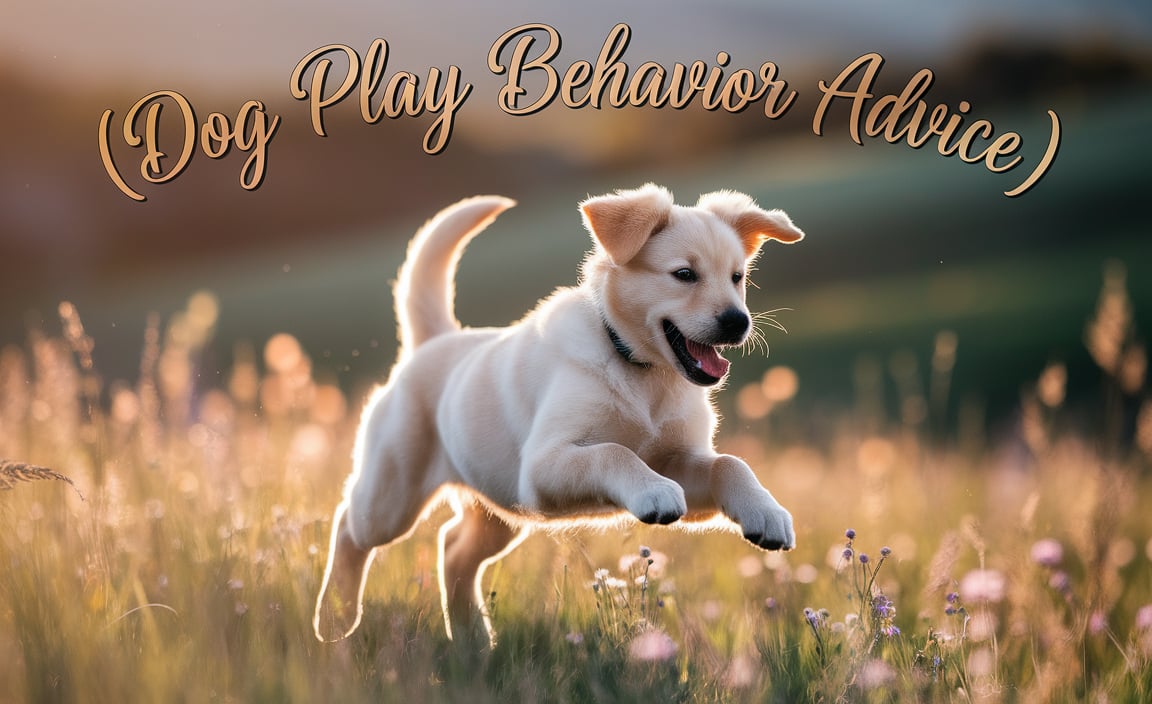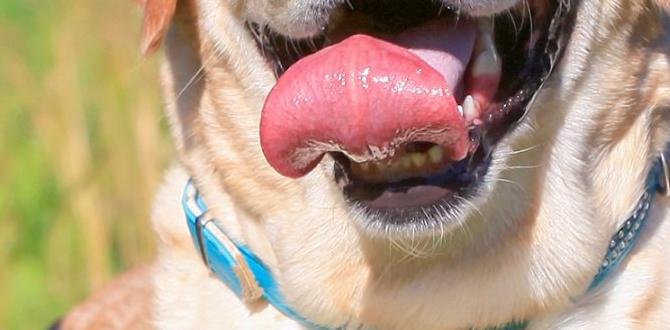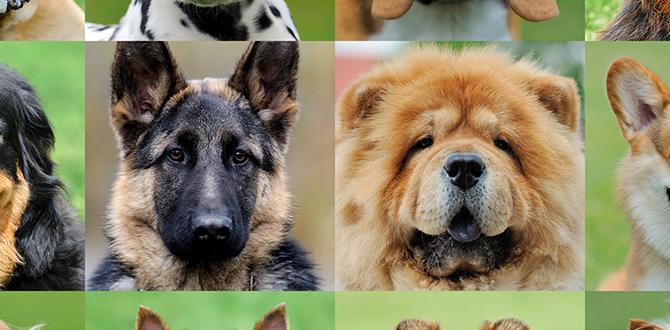Have you ever watched dogs play? It’s a joyful sight! Dogs love to run, jump, and chase. But did you know their play behavior has deep meanings? Let’s dive into some dog play behavior advice to understand our furry friends better.
Imagine a dog park on a sunny day. Dogs of all shapes and sizes play together. Some wrestle, some chase, and others play tug-of-war. What makes dogs behave like this? Let’s explore how to play safely with dogs.
Dogs communicate through play. They use body language and sounds. They tell each other when they’re having fun or when it’s too much. Understanding this can make your time with your dog even more enjoyable!

Key Takeaways
- Dogs communicate through play behavior.
- Understanding play signals prevents misunderstandings.
- Learn how to play safely with your dog.
- Dog play involves body language and sounds.
- Get expert dog play behavior advice.
Understanding Dog Play Behavior
Dogs play to communicate, learn, and bond. Play behavior shows their emotions. Happy dogs bounce, wag their tails, and give play bows. These behaviors invite others to join the fun. Dogs use their mouths and paws to interact. This play looks like fighting, but it’s friendly.
- Play bows signal a friendly invitation.
- Pinned ears show excitement.
- Loose bodies mean relaxed play.
- Barking can be playful or serious.
- Panting shows excitement or tiredness.
Understanding these signals helps you interact safely with dogs. If a dog shows stiff body language, it might be time to pause. Dogs may growl or snap if they feel threatened. Always supervise kids and pets during play. This ensures safe and fun moments together.
Fun Fact or Stats : Dogs have been playing with humans for thousands of years!
Dogs & Play: A Communication Tool
Did you know dogs talk with their tails and eyes? When dogs play, they send messages. A wagging tail is like a smile. A play bow is a friendly hello. Dogs even use their eyes to say, “Let’s play!” It’s like a secret language only dogs know.
How to Tell if a Dog Wants to Play
Can you tell when your dog wants to play? Look for play bows. Listen for happy barks. Notice the wagging tail. These signs mean, “Let’s have fun!” If a dog stares or growls, it’s time to stop. Knowing what dogs say helps keep play safe and happy.
Signs of Happy Dog Play
Happy play is easy to spot. Dogs bounce, wag tails, and make soft barks. Their bodies are loose, not stiff. They take turns chasing and being chased. Dogs love to wrestle gently. This kind of play shows joy and friendship.
Safe Play Tips for Dogs
Playing with dogs is fun, but safety is key. Dogs have different play styles. Some love to run, while others prefer to wrestle. Knowing your dog’s style helps prevent accidents. It’s important to choose the right toys. Soft toys are better than hard ones. Supervise playtime to avoid rough play.
- Choose toys based on size and breed.
- Watch for signs of stress or aggression.
- Take breaks to prevent exhaustion.
- Train dogs to play gently.
- Ensure play areas are safe and secure.
If play gets too rough, distract with a toy. Use commands like “sit” or “stay” to calm your dog. Always reward good behavior. This reinforces safe play habits. Remember, play is a bonding time for you and your dog. Keep it positive and fun!
| Play Style | Best Toys | Safety Tips |
|---|---|---|
| Chasing | Frisbees, balls | Watch for traffic |
| Wrestling | Soft plush toys | Supervise closely |
| Chewing | Chew toys, ropes | Inspect for wear |
| Puzzle | Treat puzzles | Ensure size fits |
Fun Fact or Stats : Studies show dogs prefer human interaction over toys!
Choosing the Right Toys
Do you know which toys are best for your dog? It depends on their play style. Some dogs love to chase. Others like to chew or wrestle. Soft toys are gentle on teeth. Chew toys keep dogs busy. Always choose toys that are safe and in good condition.
Supervising Dog Play
Why is supervision important? It keeps dogs safe during play. Watch for signs of stress or aggression. If dogs get too wild, step in. Distract with a toy or a command. Supervision ensures play stays fun and safe for everyone.
Training for Gentle Play
Training helps dogs play gently. Start with basic commands. Use “sit” or “stay” during play. Reward good behavior with treats. Gentle play builds trust and strengthens bonds. It’s an important part of dog play behavior advice.
Understanding Dog Body Language
Dog body language tells us a lot. A wagging tail is usually happy. But, a stiff tail means something else. Dogs use their ears, eyes, and tails to communicate. Reading these signals helps you understand your dog’s feelings. It makes playtime safe and fun.
- Wagging tail means excitement or friendliness.
- Stiff tail shows alertness or caution.
- Pinned-back ears indicate fear or submission.
- Relaxed body shows comfort and happiness.
- Direct stare can be a challenge or a greeting.
Learning dog language takes time. Spend time watching your dog. Notice how they react in different situations. This helps you spot when they need space or want to play. Understanding your dog’s body language strengthens your bond.
Fun Fact or Stats : Dogs have over 20 different tail wags!
Reading Your Dog’s Ears and Eyes
Have you seen your dog’s ears and eyes change? Ears up mean interest. Ears back show fear. Wide eyes mean excitement or surprise. Dogs use their eyes to express feelings. Understanding these cues helps you respond correctly.
What Your Dog’s Tail Says
Does your dog’s tail have a story? Yes, it does! A wagging tail means excitement. A stiff tail shows alertness. Tails down or tucked show fear. Watching a dog’s tail helps us understand their mood and intentions.
Comfortable vs. Uncomfortable Dogs
Can you spot a comfortable dog? They have relaxed bodies and wagging tails. Uncomfortable dogs show tense bodies. They might growl or snap. Understanding these signs helps you keep playtime safe and enjoyable.
Games Dogs Love to Play
What games do dogs love? Dogs enjoy a variety of games. Fetch is a favorite. Dogs love to chase and retrieve. Tug-of-war is another fun game. It helps dogs use their strength. Hide and seek challenges their noses and minds. Every game can be a fun learning time.
- Fetch keeps dogs active and engaged.
- Tug-of-war builds strength and coordination.
- Hide and seek challenges their senses.
- Puzzle games stimulate their minds.
- Chase games burn energy and build speed.
Each game has its benefits. Fetch is great for exercise. Tug-of-war teaches control. Hide and seek boosts problem-solving skills. Always ensure games are safe. Use toys that are appropriate and in good condition. Most importantly, have fun!
Fun Fact or Stats : Dogs can learn over 200 words!
How Fetch Improves Fitness
Do you play fetch with your dog? It’s a great exercise! Running and chasing keeps dogs fit. It helps build muscles and stamina. Fetch also improves coordination. It makes playtime exciting and rewarding.
Tug-of-War Rules for Safety
Is tug-of-war safe? Yes, with rules! Let dogs win sometimes. Use soft toys to protect teeth. Always have a command to stop the game. This keeps tug-of-war fun and safe for all dogs.
Brain-Boosting Puzzle Games
Do you know dogs love puzzles? Puzzle games challenge their brains. They solve problems to get treats. It keeps their minds sharp. Puzzle games are great for rainy days when outside play isn’t possible.
Conclusion
Dog play is more than just fun. It’s communication and bonding. Understanding dog play behavior advice helps you enjoy safe and happy playtimes. Remember, each dog is unique. Learn their signals and enjoy your time together!
FAQs
Question: How can I tell if my dog likes a game?
Answer: If your dog wags its tail and shows excitement, it enjoys the game. Happy barks and a playful demeanor also indicate they like the activity. Watch their body language for clues.
Question: What if my dog growls during play?
Answer: Growling can mean different things. Some dogs growl playfully. Watch their body language. If they seem tense, pause the game. Follow dog play behavior advice to ensure fun and safe playtimes.
Question: Is it okay to let dogs win in tug-of-war?
Answer: Yes! Letting dogs win can boost their confidence. It makes tug-of-war enjoyable. Ensure they know a command to stop. This keeps the play fun and safe.
Question: How can I keep toys safe for play?
Answer: Check toys regularly for damage. Discard any that are broken. Choose toys that suit your dog’s size and play style. This prevents accidents and ensures hours of safe play.
Question: Can old dogs enjoy playtime?
Answer: Yes, old dogs love play too! Adjust games to suit their pace. Gentle walks or puzzle games are great. Always monitor their comfort and health during play.
Question: What should I do if my dog doesn’t like a toy?
Answer: Try different toys or games. Each dog has preferences. Some love fetch; others prefer puzzles. Observe what makes them happiest and adjust playtime accordingly.
Meet Elyse Colburn, the devoted canine companion and storyteller behind the enchanting world of “Tales, Tails, and Adventures Unleashed.” A passionate dog enthusiast with a heart full of paw prints, Elyse Colburn shares heartwarming tales and insightful adventures, celebrating the joy, loyalty, and endless antics that make every dog a true hero. Join Elyse Colburn on this tail-wagging journey, where every post is a love letter to our four-legged friends.








